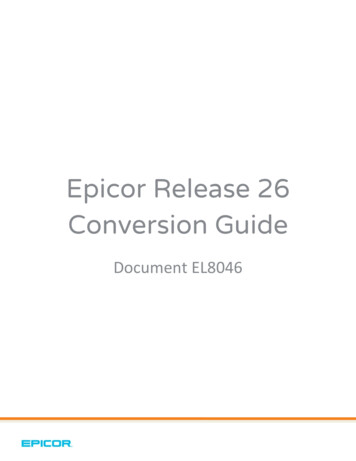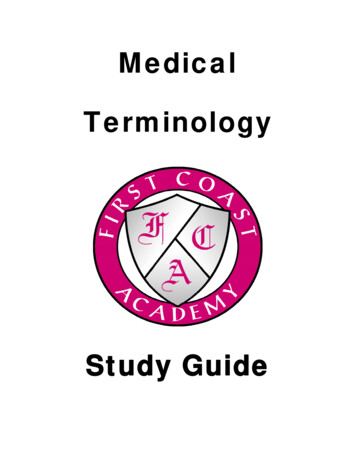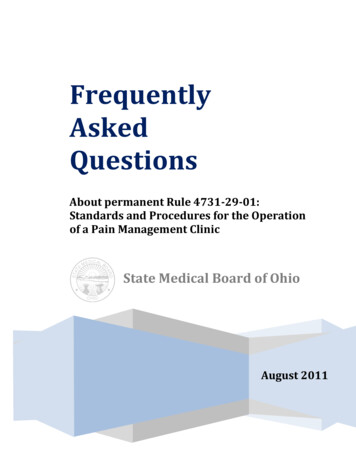
Transcription
FrequentlyAskedQuestionsAbout permanent Rule 4731-29-01:Standards and Procedures for the Operationof a Pain Management ClinicState Medical Board of OhioAugust 2011
Frequently Asked QuestionsRule 4731-29-01: Standards and Procedures for the Operation of a Pain Management Cliniceffective August 31, 2011Background:Emergency Rule 4731-29-01, Standards and Procedures for the Operation of a Pain Management Clinic,expires at midnight on Tuesday, August 30, 2011.Permanent Rule 4731-29-01, Standards and Procedures for Operation of Pain Management Clinic, has beenapproved by the Medical Board and goes into effect on August 31, 2011. The permanent rule is attached foryour reference.This document answers frequently asked questions related to the permanent rule.1. What is a pain management clinic?A pain management clinic is a facility to which both of the following apply: (i) The primarycomponent of practice is treatment of pain or chronic pain; and (ii) The majority of patients of theprescribers at the facility are provided treatment for pain or chronic pain that includes the use ofcontrolled substances, tramadol, carisoprodol, or other drugs specified in rules adopted under thissection.If both criteria are met, the facility is a “pain management clinic” even if the medical practice is afamily practice, internal medicine practice, or other type of practice not limited to pain management.2. Are pain management clinics required to be licensed?Yes.A pain management clinic must obtain a license as a Category III Terminal Distributor ofDangerous Drugs with a Pain Management Clinic Classification [pain clinic license] issued by the OhioBoard of Pharmacy. The license is required even if drugs are not kept on site.Questions about the pain clinic licensure process should be directed to the Ohio Board of Pharmacyat 614-466-4143.3. What type of facility does not need to be licensed as a pain management clinic?The following entities are not required to become licensed as a pain management clinic:1.2.3.4.5.6.7.A hospital;A facility operated by a hospital for the treatment of pain or chronic pain;A physician practice owned or controlled, in whole or in part, by a hospital or by an entity thatowns or controls, in whole or in part, one or more hospitals;A school, university, or other educational institution or program to the extent it providesinstruction to individuals preparing to practice as physicians, podiatrists, dentists, nurses,physician assistants, optometrists, or veterinarians;A hospice program;An ambulatory surgical facility;An interdisciplinary pain rehabilitation program with three-year accreditation from thecommission on accreditation of rehabilitation facilities.August 20111State Medical Board of Ohio
Frequently Asked QuestionsRule 4731-29-01: Standards and Procedures for the Operation of a Pain Management Cliniceffective August 31, 20114. Some of my patients require controlled substances to manage their pain or chronic pain. Do Ihave to get licensed as a pain management clinic?You do not need to get licensed as a pain management clinic if 50% or fewer of the patients in yourpractice are treated with controlled substances to manage their pain or chronic pain.5. Who can own a pain management clinic?A pain management clinic may only be owned and operated by one or more Ohio licensed medicaldoctors (MD) or osteopathic physicians (DO) who meet one of the following requirements:a.b.c.d.e.Hold subspecialty certification in pain management by the American Board of Medical Specialtiesor qualification in pain management by the American Osteopathic Association Bureau ofOsteopathic Specialists;Hold subspecialty certification in hospice and palliative medicine by the American Board ofMedical Specialties or qualification in hospice and palliative medicine by the AmericanOsteopathic Association Bureau of Osteopathic Specialists;Hold board certification by the American Board of Pain Medicine;Hold board certification by the American Board of Interventional Pain Physicians; orMeet both of the following:i. Hold board certification in anesthesiology, psychiatry, neurology, physical medicine andrehabilitation, occupational medicine, or rheumatology by the American Board of MedicalSpecialties or primary certification in anesthesiology, psychiatry, neurology, physicalmedicine and rehabilitation, occupational medicine, or rheumatology by the AmericanOsteopathic Association Bureau of Osteopathic Specialists; andii. Demonstrate conformance with the minimal standards of care pursuant to an investigationof the practice conducted by the State Medical Board of Ohio.6. If I hold board certification in anesthesiology, psychiatry, neurology, physical medicine andrehabilitation, occupational medicine, or rheumatology how do I demonstrate that mypractice conforms to the minimal standard of care in order to qualify to own a painmanagement clinic?Provide the Medical Board with a copy of the application for a pain clinic license submitted to theOhio Board of Pharmacy.The copy of the application will serve as a complaint which authorizes the Medical Board toinvestigate your practice. All complaints received and investigations conducted by the Medical Boardare confidential as provided in Section 4731.22(F) of the Revised Code.7. I applied for a pain clinic license under the “grandfather” provision in the Emergency rule.Will I still qualify as an owner of a pain management clinic?A physician who applied for a pain management clinic license no later than June 20, 2011, and isgranted a license by the Ohio Board of Pharmacy, is eligible to continue to own a pain managementclinic as long as all laws are obeyed and the pain clinic license is renewed on time.August 20112State Medical Board of Ohio
Frequently Asked QuestionsRule 4731-29-01: Standards and Procedures for the Operation of a Pain Management Cliniceffective August 31, 20118. Are there continuing medical education requirements for physicians who own and/orpractice at a pain management clinic?Yes. Every two years all physicians who own or practice at a pain management clinic must completeat least 20 hours of category I continuing medical education (CME) in pain medicine. One or more ofthe courses must address the potential for addiction.The courses completed in compliance with this requirement count toward the physician’s Category ICME requirement for biennial licensure renewal.9. Are there standards for the operation of a pain management clinic?Yes. The physician owner(s) of a pain management clinic provide supervision, direction and controlof care providers and employees at the pain clinic and the owner(s) must also comply with thefollowing requirements: Have proper equipment, materials, and personnel on premises to provide appropriate medicaltreatment, as required by the minimal standards of care;Comply with the Federal Drug Prevention and Control Act, 21 U.S.C. 801 tense., and Ohio druglaws in Chapters 3719, 4729, 4730, and 4731 of the Revised Code;Maintain a daily log of patients for seven years;Obtain informed consent from each patient prior to the start of treatment;Conduct a quality assurance program to monitor and evaluate the quality and appropriateness ofpatient care and meet other criteria;Document the background, training, certification, and licensure of all clinical staff and verify staffcertification and licensure each year;Maintain adequate billing records, andMaintain patient records for seven years from the last date of treatment of the patient.10. Is it necessary to obtain informed consent prior to treatment?Yes. Rule 4731-29-01 requires a patient’s informed consent prior to treatment. The informedconsent must include the following components:a.b.c.d.e.f.The patient's diagnosis;The nature and purpose of the proposed treatment or procedure;The risks and benefits of a proposed treatment or procedure;Alternatives regardless of their costs or the extent to which the treatment options are covered byhealth insurance;The risks and benefits of the alternative treatment or procedure; andThe risks and benefits of not receiving or undergoing a treatment or procedure.11. Is anyone prohibited from owning or working at a pain management clinic?Yes. No physician owner, employee, or person providing services at a pain management clinic shallhave ever:a.Been denied a DEA license or license in any state or jurisdiction based, in whole or in part, on theinappropriate prescribing, dispensing, administering, supplying, or selling a controlled substanceor other dangerous drug;August 20113State Medical Board of Ohio
Frequently Asked QuestionsRule 4731-29-01: Standards and Procedures for the Operation of a Pain Management Cliniceffective August 31, 2011b.Have had a DEA license or a license in any state or jurisdiction authorizing the holder toprescribe, dispense, administer, supply or sell a controlled substance that has been restrictedbased on inappropriate prescribing, dispensing, administering, supplying, or selling a controlledsubstance or dangerous drug;c.Been subject to disciplinary action by any licensing entity that was based on inappropriateprescribing, dispensing, diverting, administering, supplying, or selling a controlled substance ordangerous drug.12. What is the effective date of Rule 4731-29-01?Rule 4731-29-01 is effective August 31, 2011.Contact Information: Questions about permanent rule 4731-29-01 should be directed to:Sallie Debolt, General CounselState Medical Board of Ohio30 E. Broad St. 3rd FloorColumbus, OH 43215-6127(614) 644-7021Sallie.Debolt@med.state.oh.usAugust 20114State Medical Board of Ohio
4731-29-01Standards and procedures for the operation of a pain management clinic.(A) For the purposes of this rule:(1) "Board" means state medical board of Ohio.(2) "Chronic pain" means pain that has persisted after reasonable medical efforts have beenmade to relieve the pain or cure its cause and that has continued, either continuously, orepisodically, for longer than three continuous months. "Chronic pain" does not includepain associated with a terminal condition or with a progressive disease that, in the normalcourse of progression, may reasonably be expected to result in a terminal condition.(3) "Hospital" means a hospital registered with the department of health under section3701.07 of the Revised Code.(4) "Informed consent" means a process of communication between a patient and physicianthat results in the patient's signed authorization or agreement to undergo a specificmedical intervention after all of the following subjects are discussed:(a) The patient's diagnosis;(b) The nature and purpose of the proposed treatment or procedure;(c) The risks and benefits of a proposed treatment or procedure;(d) Alternatives regardless of their costs or the extent to which the treatment options arecovered by health insurance;(e) The risks and benefits of the alternative treatment or procedure; and(f) The risks and benefits of not receiving or undergoing a treatment or procedure.(5) "Owner" means each person included on the list maintained under division (B)(5) ofsection 4729.552 of the Revised Code.(6) "Pain" means an unpleasant sensory and emotional experience associated with actual orpotential tissue damage, or described in terms of such damage.(7) "Pain management clinic" means a facility to which all of the following apply:(a) The primary component of the practice is treatment of pain or chronic pain;(b) The majority of patients of the prescribers at the facility are provided treatment forpain or chronic pain that includes the use of controlled substances, tramadol,carisoprodol, or other drugs specified in rules by the board; and(c) In determining whether the facility meets the requirement of paragraph(A)(7)(b) ofthis rule:
Rule 4731-29-01 Standards and procedures for the operation of a pain management clinic.August 31, 2011(i) Calculation of the majority of patients will be based upon the number of patientstreated in a calendar month;(ii) Patients receiving controlled substances, tramadol, carisoprodol or other drugsspecified by the board, for treatment of an injury or illness that lasts or isexpected to last thirty days or less shall not be considered in the calculation ofthe majority.(8) "Pain management clinic" does not include the following:(a) A hospital;(b) A facility operated by a hospital for the treatment of pain or chronic pain;(c) A physician practice owned or controlled, in whole or in part, by a hospital or by anentity that owns or controls, in whole or in part, one or more hospitals;(d) A school, college, university, or other educational institution or program to the extentthat it provides instruction to individuals preparing to practice as physicians,podiatrists, dentists, nurses, physician assistants, optometrists, or veterinarians orany affiliated facility to the extent that it participates in the provision of thatinstruction;(e) A hospice program licensed under chapter 3712. of the Revised Code;(f) An ambulatory surgical facility licensed under section 3702.30 of the Revised Code;(g) An interdisciplinary pain rehabilitation program with three-year accreditation fromthe commission on accreditation of rehabilitation facilities.(9) "Physician" means an individual authorized under chapter 4731. of the Revised Code topractice medicine and surgery or osteopathic medicine and surgery.(10) "Prescriber" has the same meaning as in section 4729.01 of the Revised Code.(B) In the operation of a pain management clinic, the following requirements shall be met:(1) The pain management clinic shall be owned and operated by one or more physicians. Eachphysician owner of a pain management clinic shall complete at least twenty hours ofcategory I continuing medical education in pain medicine every two years, to include oneor more courses addressing the potential for addiction. The courses completed incompliance with this rule shall be accepted toward meeting the category I requirementfor certificate of registration renewal for the physician.(2) Each physician owner of a pain management clinic must meet one of the followingrequirements:Page 2
Rule 4731-29-01 Standards and procedures for the operation of a pain management clinic.August 31, 2011(a) Hold current subspecialty certification in pain management by the American board ofmedical specialties, or hold a current certificate of added qualification in painmanagement by the American osteopathic association bureau of osteopathicspecialists; or(b) Hold current subspecialty certification in hospice and palliative medicine by theAmerican board of medical specialties, or hold a current certificate of addedqualification in hospice and palliative medicine by the American osteopathicassociation bureau of osteopathic specialists; or(c) Hold current board certification by the American board of pain medicine; or(d) Hold current board certification by the American board of interventional painphysicians; or(e) Meet both of the following:(i) Hold current board certification in anesthesiology, psychiatry, neurology,physical medicine and rehabilitation, occupational medicine, or rheumatologyby the American board of medical specialties or hold current primarycertification in anesthesiology, psychiatry, neurology, physical medicine andrehabilitation, occupational medicine, or rheumatology by the Americanosteopathic association bureau of osteopathic specialists.(ii) Demonstrate conformance with the minimal standards of care.(3) To demonstrate conformance with the minimal standards of care pursuant to paragraph(B)(2)(e)(ii) of this rule:(a) The physician shall provide to the medical board a copy of the application for acategory III terminal distributor of dangerous drugs with a pain management clinicclassification under section 4729.552 of the Revised Code.(b) The copy of the application shall serve as a complaint which shall authorize themedical board to investigate the physician's practice pursuant to section 4731.22(F)of the Revised Code.(4) The pain management clinic shall be licensed as a category III terminal distributor ofdangerous drugs with a pain management clinic classification under section 4729.552 ofthe Revised Code.(5) The pain management clinic shall be operated in compliance with the drug prevention andcontrol act, 21 U.S.C. 801 et.seq., and chapters 3719., 4729.,4730., and 4731. of the RevisedCode.(6) The pain management clinic shall have proper equipment, materials, and personnel onpremises to provide appropriate medical treatment, as required by the minimal standardsof care.Page 3
Rule 4731-29-01 Standards and procedures for the operation of a pain management clinic.August 31, 2011(C) Each physician who provides care at a pain management clinic shall complete at least twentyhours of category I continuing medical education in pain medicine every two years, to includeone or more courses addressing the potential for addiction. The courses completed incompliance with this rule shall be accepted toward meeting the category I requirement forcertificate of registration renewal for the physician.(D) No physician owner of a pain management clinic, employee of the clinic, or person with whomthe clinic contracts for services shall:(1) Have ever been denied a license to prescribe, dispense, administer, supply, or sell acontrolled substance by the drug enforcement administration or appropriate issuing bodyof any state or jurisdiction, based, in whole or in part, on the prescriber's inappropriateprescribing, dispensing, administering, supplying or selling a controlled substance orother dangerous drug.(2) Have held a license issued by the drug enforcement administration or a state licensingagency in any jurisdiction, under which the person may prescribe, dispense, administer,supply or sell a controlled substance, that has ever been restricted, based, in whole or inpart, on the prescriber's inappropriate prescribing, dispensing, administering, supplying,or selling a controlled substance or other dangerous drug.(3) Have been subject to disciplinary action by any licensing entity that was based, in wholeor in part, on the prescribers inappropriate prescribing, dispensing, diverting,administering, supplying or selling a controlled substance or other dangerous drug.(E) In providing supervision, direction, and control of individuals at a pain management clinic thephysician owner shall establish and ensure compliance with the following:(1) A requirement that a log of patients be maintained for each day the clinic is in operation.(a) Each log sheet shall contain the month, day, and year;(b) Each log entry shall include the legible first and last name of each patient;(c) Each patient shall be required to sign the log at each visit; and(d) Patient logs shall be maintained for seven years.(2) A requirement that providers obtain informed consent for each patient prior to thecommencement of treatment.(3) An on-going quality assurance program that objectively and systematically monitors andevaluates the quality and appropriateness of patient care, evaluates methods to improvepatient care, identifies and corrects deficiencies within the clinic, and provides theopportunities to improve the clinic's performance and quality of care.Page 4
Rule 4731-29-01 Standards and procedures for the operation of a pain management clinic.August 31, 2011(4) A requirement that the background, training, certification, and licensure of all clinical staffbe documented. Verification of certification and licensure shall be made on an annualbasis.(5) A requirement that adequate billing records are maintained for all patients and madeavailable to the board, immediately upon request.(a) Billing records shall include the amount paid, method of payment, description ofservices, sufficient information to identify the patient, and the amounts charged to thepatient for each date of service,(b) Billing records shall be maintained for seven years from the last date of treatment ofthe patient.(6) A requirement that adequate patient records are maintained for all patients and madeavailable to the board, immediately upon request.(a) Patient records shall contain sufficient information to identify the patient, support thediagnosis, justify the treatment and document the course and results of treatmentaccurately, by including, at a minimum:(i) Patient history and physical examination, including history of drug abuse ordependence;(ii) Diagnostic, therapeutic, and laboratory results, including drug testing results;(iii) Reports of evaluations, consultations, and hospitalizations;(iv) Treatment objectives, including discussion of risks and benefits;(v) Records of drugs prescribed, dispensed or administered, including the date, type,and dosage;(vi) Treatments;(vii) Receipt and assessment of drug database or prescription monitoring programreports;(viii) Copies of records or reports or other documentation obtained from otherhealth care practitioners at the request of the physician and relied upon by thephysician in determining the appropriate treatment of the patient. Recordsprovided by the patient shall be designated as such.(b) Patient records shall be maintained for seven years from the last date of treatmentof the patient.(c) In the treatment of chronic pain the patient records shall contain the informationrequired in rule 4731-21-02 of the Administrative Code in lieu of the requirementsof paragraph (E)(6)(a)(i) through (E)(6)(a)(vi) of this rule.Page 5
Frequently Asked Questions Rule 4731-29-01: Standards and Procedures for the Operation of a Pain Management Clinic effective August 31, 2011 August 2011 State Medical Board of Ohio 2 4. Some of my patients require co
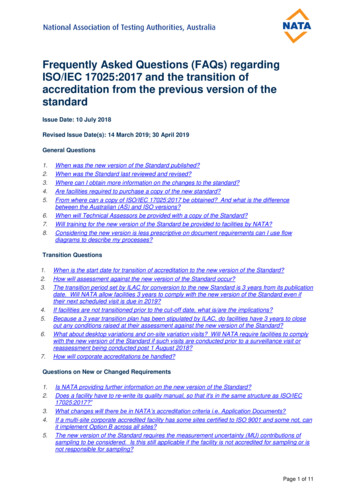
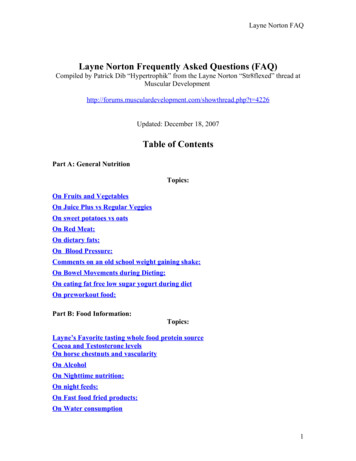
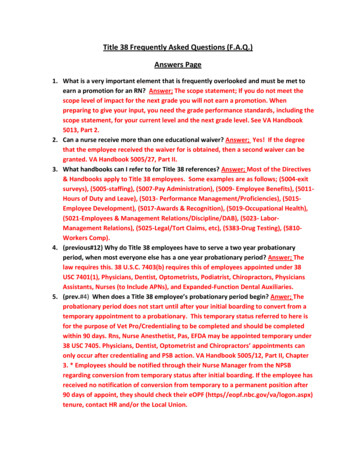
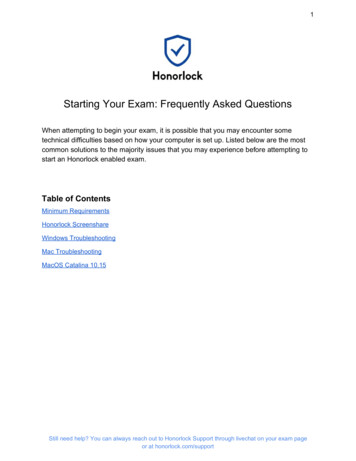
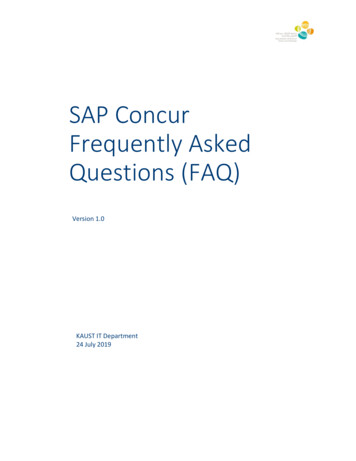
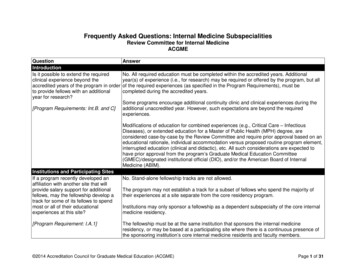
![Informatica Interview Questions and Answers [Scenario-Based]](/img/2/informatica-interview-questions-and-answers-scenario-based-1.jpg)

